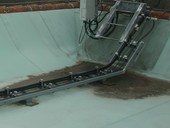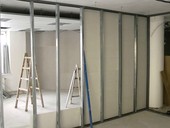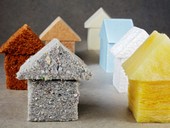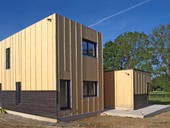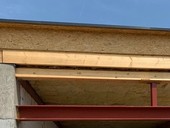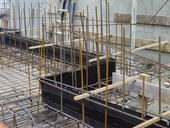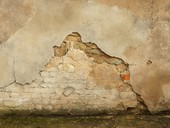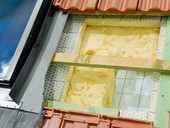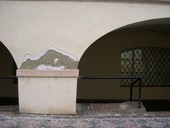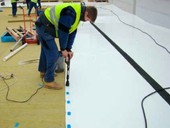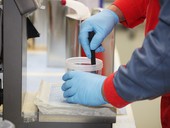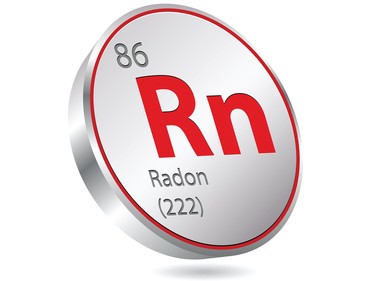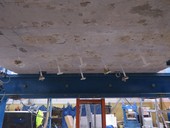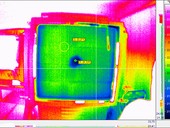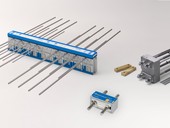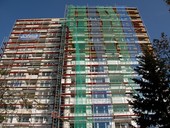The paper deals with construction modifications of the public building complex roof, which was repeatedly flooded. The roof structure consists of a combination of a sloped roof around the perimeter of the building and a flat roof above the inner space of the floor plan. In the article the authors focus on solving the atypical detail required by the roof modifications.
Archiv článků od 14.1.2019 do 5.10.2020
In modern building systems, sound insulation of walls is often made of multi-layer structures. This article deals with the acoustic operation of such structures and discusses the importance of proper implementation. It also warns against limited sound insulation at low frequencies, which is often not given enough attention. Software for calculating sound insulation - INSUL - was used to compare the acoustic behavior of structures and for simulations.
From the point of view of sustainable development in construction, the possibility of using easily renewable raw materials for the production of advanced thermal insulation materials currently represents an interesting way to effectively reduce the energy consumption of buildings. Insulators with ever-increasing thicknesses are being utilised in buildings; the use of these raw materials allows for the insulators’ production without the need for a substantial increase in CO2 emissions and energy consumption.
Natural fibres generally display very low thermal conductivity. Despite their relatively great thickness (in the case of technical fibres) these fibres are porous, and upon reducing pressure they show significant loss of thermal conductivity. Remarkably, it is the same in the case of materials based on glass fibres, which are used industrially in the production of vacuum insulators. When using natural materials as thermal insulators there is a common problem with their high sensitivity to humidity and consequent degradation of thermal insulating properties upon increasing their water content. In the case of using natural fibres for the production of vacuum insulators, these fibres are protected against humidity by a barrier foil that creates a vacuum insulation panel (moreover, the panel also always contains an active dryer), this is why their use in this field is so interesting.
The unfavourable effects of the weather on unprotected wood and timber products can cause changes to the mechanical and chemical properties of the wood, and if unchecked can do irreversible damage. The sheathing of wooden buildings must always be supplemented with surface treatments, and in a large number of cases a contact thermal insulation system is used. The paper presents research focused on the possibility of using a commonly used cement adhesive for bonding thermal insulation to the substrate formed by oriented strand boards. The substrate is provided with several types of penetration coatings or bonding primers and subsequently their influence on the adhesion of the cement adhesive is monitored. The best values were achieved when treating the surface treatment with a modified dispersion with quartz sand. On the other hand, the penetration coating of a mixture of water, nanodispersion of styrene-acrylate copolymer and additives is inappropriate treatment.
Contractors tend to ignore design solutions to reduce the cost of construction. Change of materials, absence of building elements, adjustment of layer composition, application of cheaper alternatives – these are common situations in construction practice. In certain cases, these modifications are without consequences, but in such a situation it is necessary, among other things, to take into account the laws of physics. This article deals with the case in which the structure was replaced – instead of the reinforced concrete ceiling slab, the contractor chose a wooden structure. Wood has significantly different properties than reinforced concrete, so it is necessary to take into account several aspects such as statis, thermo-technical properties and last but not least – with whitch this article deals with – moisture conditions in the structure. The relationship of wood and moisture is specific, the article assesses a specific case of such a structure, lists the possible consequences and finally suggests the most appropriate solution – adjusting the composition of this particular ceiling structure to meet the requirements.
White tanks are structures which, in addition to the load-bearing function, must also have the function of watertightness. Watertight of the concrete is ensured by adherence to design, production and technological measures. The width of the early-age cracks that former in the structure is controlled by the reinforcement. During construction, however, joints (expansion, construction and control) are created in the structure, which must also be watertight. The joints are the most sensitive place of the white tank and therefore the most leaks are created at the point of the joints. The correct choice of the joint sealing system is the basis for the design of the watertight joint. The paper deals with the description of various joint seal and pipes through of the white tank.
The elementary aim of the described research is to prove the necessity of creating an additional impermeable layer acting as moisture insulation of historical structures by means of undercutting technology. From a technological point of view and also based on known research, it is obvious that this technology is one of the most effective remediation methods. Unfortunately, the use of this technology is from the point of view of Regional Monuments Authorities, which, due to adherence to the uncompromising Venetian Charter, is considerably limited, because, despite considerable efficiency, this technology disrupts the integrity of historical vertical structures. The methodology of research into undercutting technology consists in verifying and demonstrating the effectiveness of this technology in various historical buildings and recording individual moisture values in situ before and after the implementation of the technology. The results measured in this way should objectively prove the necessity of using the technology of undercutting masonry as a remediation method of wet historical structures, provided that this does not compromise the statics of the object and this intervention is necessary.
In this paper, the authors consider the aspects of routine procedure compared to the expert approach in solving construction defects and failures. For better orientation in the issue the basic terminology of defects and failures sphere is given. Also, the authors describe in details the course of both solutions, contemplate their specific aspects and point out their consequences. An essential part of the article is presentation of the potential benefits of the expert approach, the advantages of the expert approach are emphasized in the conclusion.
The paper discusses the importance of water absorption of traditional building materials and the ability of traditional non-insulated buildings to withstand rising damp. It also draws attention to some of the risks involved in reducing the water absorption of building materials designed for remediation of moisture and salts problems of traditional buildings.
Any roof likely to fall from a height shall be fitted with a handrail or restraint system as appropriate for the intended operation. Protection of persons against falls from a height must be addressed already during construction. Therefore, Act No. 309/2006 Coll. in its current wording, it specifies the work of the contractor and sets out its obligations. In addition to this Act updated in 2016, it is of course necessary to take into account other legislative requirements in the construction process. This implies many responsibilities of individual construction participants, which will be discussed in this paper.
The article describes all significant changes in the field of designing and implementing radon protective and remedial measures introduced by the revised version of ČSN 73 0601, which came into force on 1.10.2019. A new way of selecting measures according to the building type and new concept of designing according to the design values of input parameters are introduced. A new methodology for designing radon-proof insulations is described in detail. According to this methodology, only insulation with a radon resistance greater than the prescribed minimum radon resistance can be used for building protection.
The contribution deals with the experiment verifying the load bearing capacity of anchors for ETICS with thermal insulation of higher thicknesses. In connection with the increase of the requirements for the energy performance of buildings, the thermal insulation thicknesses are increased to meet the design conditions.
Nowadays, when the demands on the thermal insulation envelope of buildings are increasing, the importance of thermal bridges on the overall thermal loss of the envelope increases. Point thermal bridges are often neglected in the calculations but can lead to an increase in heat loss by an envelope of up to 35%. Significant point thermal bridges are, among other things, elements which ensure anchoring of structures protruding in front of the façade fulfilling the supporting function, since the main emphasis is placed on the bearing capacity of such an element. Several variants of anchoring systems with thermal bridges are available on the market. This paper deals with the thermal-technical assessment of the selected anchoring system and its experimental verification during loading in the climatic chamber.
The application of external wall insulation systems is frequent today due to the increasing demand for energy saving in buildings. The structures attached in front of the facade fulfilling the supporting function must be sufficiently anchored to the external load-bearing structures. The thermal bridges solution in the anchoring system is an important factor beyond the bearing capacity. Several variants of anchor systems are available on the market to deal with thermal bridges. This article introduces the currently available solutions and presents experimental results of the selected anchoring system.
The paper presents results of a study on potential reduction of CO2 emissions of the Czech national building stock until 2075. The calculations were based on datasets provided by Chance for Buildings that modeled five different scenarios of energy savings in the Czech building stock that varied by the depth of the energy retrofitting measures and by the pace of their application. The results were compared to the carbon budget that was set in line with the objectives of the Paris agreement.
Construction and renovation often brings thermal-technical challenges in certain details of certain structures. These details often place strict limitations on the thickness of thermal insulations. This is where the so-called superinsulations (i.e. materials with exceptionally low thermal conductivity) can find good use. The paper focuses on the use of these superinsulation materials in the remediation of thermal bridges in door and window jambs.
Paper deals with the definition of energy flexible building, its impact on the stability of the grid with the planned increasing share of energy from renewable sources and the possibility of using the heat storage capacity of building structures. Paper further analyzes the selected methodology for evaluation of the energy flexibible building and gives an example of thermally activated building structures.
Oak wood is characterized by good durability against biotic damages. However, its surface treatment by coatings is problematic, especially in the exterior expositions. In most cases, there is a rapid degradation and damage caused by weathering. Transparent variants of coating systems suffer from this phenomenon even more than pigmented ones. The article contains the results of practical experiments that lead to some general recommendations, which use leads to surface treatment of oak wood in exterior with longer durability and better colour stability.
zpět na aktuální články
